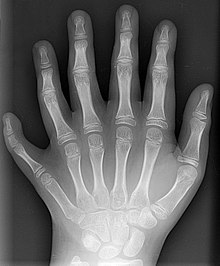Digit (anatomy)

A digit is one of several most distal parts of a limb, such as fingers or toes, present in many vertebrates.
Names
Some languages have different names for hand and foot digits (English: respectively "finger" and "toe", German: "Finger" and "Zeh", French: "doigt" and "orteil").
In other languages, e.g.
Human digits


Humans normally have five digits on each extremity. Each digit is formed by several bones called
| Fingers | Thumb | Index | Middle | Ring | Little |
|---|---|---|---|---|---|
| Toes | Hallux | Long |
Third |
Fourth |
Fifth
|
Brain representation
Each finger has an orderly somatotopic representation on the
The somatosensory cortex representation of the hand is a dynamic reflection of the fingers on the external hand: in syndactyly people have a clubhand of webbed, shortened fingers. However, not only are the fingers of their hands fused, but the cortical maps of their individual fingers also form a club hand. The fingers can be surgically divided to make a more useful hand. Surgeons did this at the Institute of Reconstructive Plastic Surgery in New York to a 32-year-old man with the initials O. G.. They touched O. G.’s fingers before and after surgery while using MRI brain scans. Before the surgery, the fingers mapped onto his brain were fused close together; afterward, the maps of his individual fingers did indeed separate and take the layout corresponding to a normal hand.[5]
Evolution

Two ideas about the homology of arms, hands, and digits exist.
- That digits are unique to
- That sarcopterygian fish.[8]
Until recently, few transitional forms were known to elaborate on this transition. One particular example is Panderichthys, a coastal fish from the Devonian period 385 million years ago. Prior to 2008, Panderichthys was interpreted as having a fin terminating at a single large plate surrounded by lepidotrichia (fin rays). However, a 2008 study by Boisvert et al. determined that this was mistaken. They discovered that the final bony portion of the fin in Panderichthys is split into at least four fin radials, bones similar to rudimentary fingers.[9]
Thus, in the evolution of tetrapods a shift occurred where the outermost rays of the fins were lost and replaced by the inner radials, which evolve into the earliest digits. This change is consistent with additional evidence from the
Several rows of digit-like distal fin radials are present in
Digit-like radials are also known in the rhizodont fish Sauripterus, though this is likely a case of convergent evolution. Elpistostege, a tetrapodomorph fish closely related to Tiktaalik, preserves one of the most tetrapod-like hands in any prehistoric fish. The hand of Elpisostege had 19 distal fin radials arranged into blocks up to four radials long. These sequential blocks of radials are very similar to digits.[11]
Bird and theropod dinosaur digits
Birds and
See also
- Polydactyly in early tetrapods
- Polydactyly
Notes
- ^ Dwight T (1892). "Fusion of hands". Memoirs of the Boston Society of Natural History. 4: 473–486.
- PMID 15320953.
- PMID 18245039.
- S2CID 21042040.
- PMID 8386377.
- ^ Holmgren N. (1933). On the origin of the tetrapod limb. Acta Zoologica 14, 185–295.
- ^ Vorobyeva EI (1992). "The role of development and function in formation of tetrapod like pectoral fins". Zh. Obshch. Biol. 53: 149–158.
- ^ Watson DMS (1913). "On the primitive tetrapod limb". Anat. Anzeiger. 44: 24–27.
- ^ S2CID 2588617.
- ^ Than, Ker (September 24, 2008). "Ancient Fish Had Primitive Fingers, Toes". National Geographic News. Archived from the original on September 27, 2008.
- S2CID 213171029.
- ^ S2CID 4358448.

